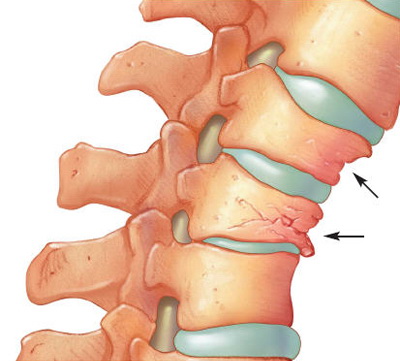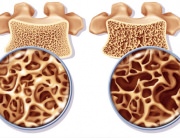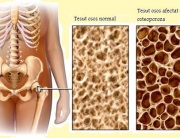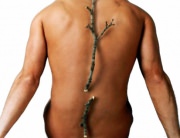The vertebral column (backbone) (backbone) extends from the skull to the pelvis and it is made up of 33 bones, called vertebrae. The vertebrae are disposed in a metameric structure (one above the other), and the spaces delimiting the vertebrae host the intervertebral discs, whose role is to absorb shocks. These intervertebral discs ensure the flexibility of the vertebral column. Vertebrae more exposed to osteoporosis , because they are made up of a softer bone tissue than the other bones in the body.
Osteoporosis causes the thinning, weakening and fragility of the bones. If weakened, the vertebrae may fracture and collapse under normal pressure. The thinned bones may collapse during routine activities, causing vertebral fractures. Compression fractures cause severe pain and can permanently alter the shape and strength of the vertebral column.
Vertebral fracture, generally caused by osteoporosis is called compression vertebral fracture, being characterized by a height loss of approximately 15-20% of the fractured vertebra (decrease visible upon X-ray). These compression fractures can affect any vertebra, but they generally occur in the upper back area (thoracic spine), in the lower vertebrae of the region (thoracic vertebrae T10, T11 and T12). These fractures very rarely affect vertebrae above T7.
Have you ever experienced back pain and you were worried that they might be caused by a vertebral fracture? Many people, especially those suffering from osteoporosis, experience severe back pain caused by vertebral fractures. These fractures are very painful and cause the deformation of the spine and immobility.
What Is a Vertebral Fracture?
The term vertebral fracture defines any fracture affecting the spine bones. These fractures cause sharp back pain and can affect walking, sitting, standing or weight lifting. Vertebral fractures are also known as compression vertebral fractures. They are caused by the compression of vertebrae. The most efficient method to prevent compression vertebral fractures is to prevent and treat osteoporosis.
In some cases, the pain caused by a vertebral fracture is so sharp that patients can have a difficult time in making the slightest effort. Standing and sitting are very uncomfortable, and most patients with vertebral fractures need assistance to carry out common activities.
Which Persons Are Most Exposed to Vertebral Fractures?
Women, especially those aged above 50, are more prone to vertebral fractures. It has been estimated that up to the age of 75, more than 50% of the women experienced a vertebral fracture. The estimations calculate approximately 5,000 vertebral fractures every year in Romania. Men can also experience vertebral fractures, and any person suffering from osteoporosis features a higher risk than healthy persons.
Age plays an important role in the appearance of vertebral fractures. With the age, your bones become weaker and thinner, and this especially applies in the case of people suffering from osteoporosis. The extensive effort made by the elderly to stand is sufficient to cause a vertebral fracture. The elderly suffering from osteoporosis put an excessive strain on the spine by constantly bending their backs. This bending applies a pressure that is several times higher than the pressure exerted by the body weight. The additional pressure can lead to vertebral fractures.
What Are the Symptoms of a Vertebral Fracture?
Vertebral fracture symptoms include:
- sudden and sharp back pain;
- the accentuation of the pain when standing or walking;
- pain and difficulty when bending or turning;
- sudden height drop;
- deformation of the spine – curved spine position, “hump”.
You may experience fractures in several vertebrae, which expands the painful symptomatology to several weeks. If you have been experience pain for several days, see a doctor, because you might suffer from other associated diseases. Moreover, inform your doctor in case you notice changes in the urination and defecation processes.
How Are Vertebral Fractures Treated?
Vertebral fractures can be identified through X-ray or CT scans. Your doctor will examine the appearance of the spine and will determine the severity of the vertebral fracture. The treatment can include the spinal fixation using a prosthesis. Some fractures may require surgery, depending on their severity.
Another investigation that the doctor may perform is the bone mineral density study (osteodensitometry). To this end, he will request you to perform a DXA – or DEXA scan. DXA means dual X-ray absorptiometry and it is the preferred bone density measurement method.
DXA is an easy to perform test, and the radiation exposure level is low. The DXA scan is performed using a device that generates a dual X-ray beam. Each beam generates a different level of energy: a high intensity and a low intensity beam. The X-ray quantity crossing the bone is measured for each beam. This value varies depending on the bone mineral density, which will be measured by calculating the difference between the two beams.
How Are Vertebral Fractures Prevented?
A calcium- and vitamin D-rich diet, alongside regular exercising, are essential to prevent osteoporosis and vertebral fractures. Talk to your general practitioner on the osteodensitometry, to measure the strength of your bones, and then take preventive measures to keep them healthy. It is never too early – or too late – to prevent bone loss.









